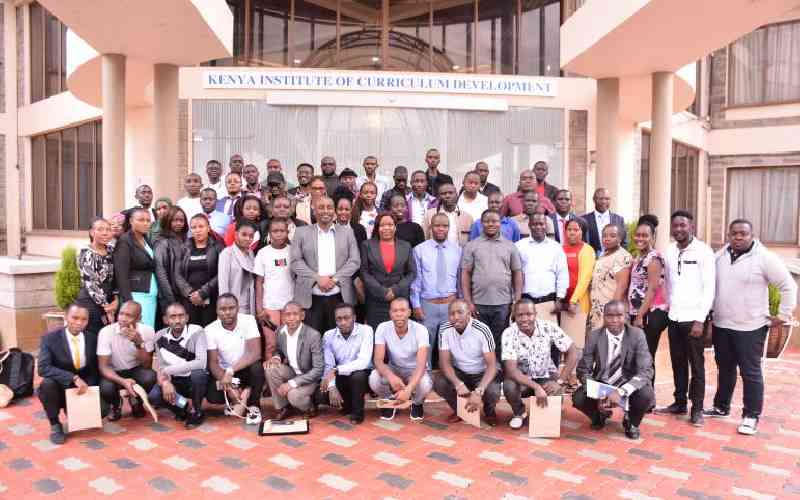Unesco lauds Kenya for leading continent in coding education
Unesco lauds Kenya for leading continent in coding education The Standard


Kenya Recognized as First African Country to Teach Coding in Schools

The United Nations (UN) has recognized Kenya as the first country in Africa to approve content for teaching computer programming lessons in primary and secondary schools. This achievement aligns with the Sustainable Development Goals (SDGs) set by the UN to promote quality education and foster innovation and technology.
Unesco Report Highlights Kenya’s Support for Digital Literacy
In a report published on Wednesday, Unesco lauded Kenya for its support of digital literacy under the new curriculum. The report titled ‘Technology in Education: A Tool on Whose Terms?’ explores the impact of technology on education by surveying school systems globally.
“Kenya has become the first African country to incorporate coding as a subject in primary and secondary schools under the new Competency-Based Curriculum (CBC). The Kenya Institute of Curriculum Development has approved a coding skills curriculum developed by Kodris Africa for children aged seven to 16 in the Python programming language,” states the report.
The Significance of Coding Education
Coding, also known as programming, is the process of giving instructions to a computer to perform specific tasks. As technology advances, the demand for skilled tech professionals, such as software developers, web designers, and data analysts, is on the rise. Learning to code opens up numerous career opportunities in various industries, from healthcare to finance and entertainment.
The US Labor Statistics reports that the number of jobs in computer and information technology occupations is projected to grow 13% from 2021 to 2031, much faster than the average for all occupations.
Disparities in Computer Science Education
The Unesco report highlights that a global review estimated that 43% of students in high-income, 62% in upper-middle-income, and only 5% in lower-middle-income countries take computer science as a compulsory subject in primary and/or secondary education. However, this is not the case in low-income countries.
Addressing this disparity is crucial in achieving SDG 4, which aims to ensure inclusive and equitable quality education for all.
#TechOnOurTerms Campaign and Urgent Need for Digital Skills
The report was released along with a #TechOnOurTerms campaign, emphasizing the importance of policymakers considering their context and the needs of marginalized communities when making decisions regarding technology in education.
Given the low levels of digital skills in the global population and the ever-increasing complexity of the digital world, countries need to urgently define digital skills and decide how best to increase them among their citizens, the UN report says. This aligns with SDG 9, which promotes industry, innovation, and infrastructure.
SDGs, Targets, and Indicators
| SDGs | Targets | Indicators |
|---|---|---|
| SDG 4: Quality Education | Target 4.4: By 2030, substantially increase the number of youth and adults who have relevant skills, including technical and vocational skills, for employment, decent jobs, and entrepreneurship | Indicator 4.4.1: Proportion of youth and adults with information and communications technology (ICT) skills, by type of skill |
| SDG 8: Decent Work and Economic Growth | Target 8.2: Achieve higher levels of economic productivity through diversification, technological upgrading, and innovation, including through a focus on high-value added and labor-intensive sectors | Indicator 8.2.2: Annual growth rate of real GDP per employed person |
| SDG 9: Industry, Innovation, and Infrastructure | Target 9.5: Enhance scientific research, upgrade the technological capabilities of industrial sectors in all countries, in particular developing countries, including, by 2030, encouraging innovation and substantially increasing the number of research and development workers per 1 million people and public and private research and development spending | Indicator 9.5.1: Research and development expenditure as a proportion of GDP |
1. Which SDGs are addressed or connected to the issues highlighted in the article?
SDG 4: Quality Education
The article discusses the incorporation of coding as a subject in primary and secondary schools in Kenya. This aligns with SDG 4, which aims to ensure inclusive and equitable quality education and promote lifelong learning opportunities for all.
SDG 8: Decent Work and Economic Growth
The article mentions the increasing demand for skilled tech professionals and the career opportunities that learning to code can provide. This relates to SDG 8, which focuses on promoting sustained, inclusive, and sustainable economic growth, full and productive employment, and decent work for all.
SDG 9: Industry, Innovation, and Infrastructure
The article highlights the importance of technological advancements and innovation in various industries. This connects to SDG 9, which aims to build resilient infrastructure, promote inclusive and sustainable industrialization, and foster innovation.
2. What specific targets under those SDGs can be identified based on the article’s content?
Target 4.4: By 2030, substantially increase the number of youth and adults who have relevant skills, including technical and vocational skills, for employment, decent jobs, and entrepreneurship
The article emphasizes the importance of coding skills for future employment opportunities, aligning with this target under SDG 4.
Target 8.2: Achieve higher levels of economic productivity through diversification, technological upgrading, and innovation, including through a focus on high-value added and labor-intensive sectors
The article mentions the increasing demand for tech professionals and the potential economic growth that can be achieved through technological advancements, supporting this target under SDG 8.
Target 9.5: Enhance scientific research, upgrade the technological capabilities of industrial sectors in all countries, in particular developing countries, including, by 2030, encouraging innovation and substantially increasing the number of research and development workers per 1 million people and public and private research and development spending
The article highlights the importance of technological advancements and innovation in various industries, which relates to this target under SDG 9.
3. Are there any indicators mentioned or implied in the article that can be used to measure progress towards the identified targets?
The article does not explicitly mention any indicators related to the identified targets. However, potential indicators that can be used to measure progress towards these targets include:
– Indicator 4.4.1: Proportion of youth and adults with information and communications technology (ICT) skills, by type of skill
– Indicator 8.2.2: Annual growth rate of real GDP per employed person
– Indicator 9.5.1: Research and development expenditure as a proportion of GDP
These indicators can help track the acquisition of coding skills, economic productivity, and research and development efforts related to technological advancements.
4. Table: SDGs, Targets, and Indicators
| SDGs | Targets | Indicators |
|---|---|---|
| SDG 4: Quality Education | Target 4.4: By 2030, substantially increase the number of youth and adults who have relevant skills, including technical and vocational skills, for employment, decent jobs, and entrepreneurship | Indicator 4.4.1: Proportion of youth and adults with information and communications technology (ICT) skills, by type of skill |
| SDG 8: Decent Work and Economic Growth | Target 8.2: Achieve higher levels of economic productivity through diversification, technological upgrading, and innovation, including through a focus on high-value added and labor-intensive sectors | Indicator 8.2.2: Annual growth rate of real GDP per employed person |
| SDG 9: Industry, Innovation, and Infrastructure | Target 9.5: Enhance scientific research, upgrade the technological capabilities of industrial sectors in all countries, in particular developing countries, including, by 2030, encouraging innovation and substantially increasing the number of research and development workers per 1 million people and public and private research and development spending | Indicator 9.5.1: Research and development expenditure as a proportion of GDP |
Behold! This splendid article springs forth from the wellspring of knowledge, shaped by a wondrous proprietary AI technology that delved into a vast ocean of data, illuminating the path towards the Sustainable Development Goals. Remember that all rights are reserved by SDG Investors LLC, empowering us to champion progress together.
Source: standardmedia.co.ke

Join us, as fellow seekers of change, on a transformative journey at https://sdgtalks.ai/welcome, where you can become a member and actively contribute to shaping a brighter future.







